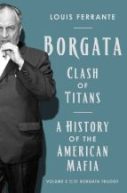Borgata: Clash of Titans: A History of the American Mafia: Volume 2 of the Borgata Trilogy
 Author: Louis Ferrante
Author: Louis Ferrante
Publisher: Simon & Schuster, 2025. 432 pages.
Reviewer: Fredrick T. Martens | Winter 2025
With so little original research on organized crime conducted in the United States, Louis Ferrante’s second volume of a trilogy provides a healthy wake-up call to those social scientists and Mafia aficionados who wish to make their mark unraveling the mysteries that often go undetected when addressing organized crime. Living during the Cuban Missile Crisis, and the assassinations of both John F. and Robert F. Kennedy, this second volume is not only nostalgic but more importantly, an autopsy on these history-changing events.
Quite prophetically, buried in this 334-page (not including end-notes and sources) treatise is a Freudian warning: “In an age when fact is becoming increasingly indistinguishable from fiction…history has left us with a small clue as to how this national tragedy began” (p. 221).
It is here that Ferrante takes his place in the annals of “Kennedy assassination conspiratorialists.” In methodically dissecting the Warren Commission Report on the assassination of President John F. Kennedy and excoriating its conclusions, Ferrante argues that this Report was “beginning the biggest cover-up of all times, which is going on today” (p. 204).
Ferrante creatively weaves together meetings, intercepted telephone conversations of Mafia bosses and their associates, CIA operatives and their surrogates, FBI leaders and informants, and the activities of the so-called “lone assassin,” Lee Harvey Oswald. He mostly supports what Professor Emeritus G. Robert Blakey concluded: The Mafia was behind the assassination of President Kennedy (pp. 135, 190, 330; Blakey1).
However, Ferrante is much bolder, pinning the assassination on Mafia boss Carlos Marcello of Louisiana. “Marcello’s primary goal was to knock out Bobby Kennedy, which succeeded…Marcello may have been the only conspirator who got exactly what he wanted…after Bobby’s departure from the Justice Department…Marcello’s Gulf Coast empire was again running at full steam…” (pp. 205, 210, 332-334).
For conspiratorialists, their deniers, and the skeptics, Ferrante does a credible albeit circumstantial analysis of the evidence and the motivations that drove Robert F. Kennedy and the FBI Director, J. Edgar Hoover to welcome and endorse the “lone assassination theory” (pp. 207, 216, 217). Self-interest on their part dictated this conclusion.
Notwithstanding the ad-hominins that Ferrante needlessly but quite comically uses to make his points (pp. 41, 212, 221, 243, 249, 257), Ferrante’s historical “facts” are likely to be challenged and ultimately used to discredit his “research.” For example, I know of no evidence that Carlos Marcello was a member of the ruling Commission (p. 167) or that “Crazy Joe Gallo” acted as “Bobby Kennedy’s bodyguard” (p.33). There are other vignettes Ferrante mentions which defy credulity.
Nonetheless, his familiarity with the inner workings of Mafia families should not be discounted. Plenty of evidence supports Ferrante’s insightful analysis.2
Ferrante’s depiction of the Profaci-Columbo-Gallo wars will resonate among the investigators and journalists who had a front-row seat to these tumultuous times. While Ferrante may not add to the historical record (although he does in some instances), he certainly corroborates, replicates, and most of all, provides a sizable compendium and relevant source material that can be explored for their historical value.3
And for those who often think that the current political climate could not get worse, Ferrante opens a window into a world shaped by transnational contract assassinations, domestic intrigue and chicanery, and systemic corruption on a scale not even envisioned by today’s opaque standards.
Ferrante cites a litany of sobering patterns that currently prove prescient. Appointing an unqualified brother, “Bobby” Kennedy as the Attorney General who stifled a free press and weaponized the Justice Department (pp. 49, 61, 74); “Bobby” Kennedy’s willful blindness when it came to investigating what was believed to be a stolen election in 1960 (pp. 43-44; 50-52); “Bobby’s” public vilification of the Teamsters Union and its leader James Hoffa, while ignoring the mob connections of the Auto Workers Union and its leader, Walter Reuther, who contributed handsomely to his brother’s election (p. 34); accepting undisclosed dark money from persons with underworld connections (pp. 46, 287, 317); and insinuating the Mafia into revered government institutions such as the FBI, CIA, DOJ, and POTUS (pp. 48, 101-103).
Ferrante concludes this volume by invoking one of his often favorite literary strategies—quoting renowned philosophers.
“When the wild beasts of a forest have hunted down their prey, there comes the difficulty of tearing it into equal or rather into satisfying shares, which mostly ends in renewed bloodshed” (p. 334).4
To some, Ferrante’s view of society may seem crude, inhuman, and cynical. Ironically, this figure of speech is Ferrante’s asset and conversely, his liability. As a writer, an author, and an aspiring cognoscente who would like his research to be taken seriously, it reinforces his Darwinian view of society (p.2).
To paraphrase a famous entertainer, Frankie Valli, who Ferrante conspicuously mentions (p. 258), “You can take the man off the street, but you can’t take the street out of the man.”
This captures the essence of Borgata: Clash of Titans.
References:
- Blakey, G. Robert and Richard N. Billings (1981). The Plot To Kill The President: Organized Crime Assassinated F.K. New York: Times Books.
- Raab, Selwyn (2016). Five Families: The Rise, Decline, and Resurgence of America’s Most Powerful Mafia Empires. St. Martin’s Press.
- The Columbo Mafia Crime Family: The Complete History of a New York Crime Organization (2024). Publisher: Mafia Library.
- Machiavelli, Niccolo (1532). The Prince. Publisher: Antonio Blado d’Asola.
Frederick T. Martens is a former President of the International Association for the Study of Organized Crime (IASOC).

